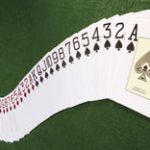Bridge By The Lake
By Ken Masson

One such ploy is The Morton’s Fork Coup, a play that presents a defender with two losing options. It’s named after the Archbishop of Canterbury John Morton (1420 – 1500). The late expert and New York Times Bridge Columnist Alan Truscott is credited with inventing the bridge term in the 1960s.
As the tax collector for King Henry VII, the Archbishop’s rule on taxes went something like this: If the King’s subjects were living lavishly, then they must be able to afford higher taxes. If they were living modestly, then they must have the savings to afford higher taxes. Either way … higher taxes.
During the North American Bridge Championships last Fall the illustrated hand occurred during a high level knock-out tournament. As shown on Bridge Base Online, West opened a wafer-thin weak 2 hearts in second seat and North jumped directly to 3 no trump, a bid that showed a long running minor with a stopper in the opponents’ suit and eight plus tricks.
When the bidding came back to South he decided to explore slam possibilities. 4 clubs asked for more information and 4 diamonds showed a stopper in that suit. 4 no trump invited slam and North accepted in his long and almost solid suit, clubs.
As luck would have it, the bidding had placed South, with the shorter trump holding, as declarer meaning that West could not afford to lead a heart with his imperfect collection whereas if North had been declarer a heart lead from East would have sunk the contract right away. Instead West led the jack of spades, the unbid suit, which declarer won in hand with the ace.
With scarcely a moment’s time out, South crossed to dummy with a trump noting that both opponents followed. He now made to key play of leading the diamond 2 from the dummy and East was well and truly impaled on Morton’s Fork. If East rose with the diamond ace, declarer would later be able to discard two losing hearts on the spade king and diamond queen. If, on the other hand, East allowed the queen of diamonds to win the trick, declarer could pitch the now singleton diamond king on spade king. In either event, 6 clubs was making.
The most impressive part of this hand to my mind was the speed with which South recognized the only way in which he could make his contract. It could be said that declarer was fortunate to find the diamond ace with East, a necessary condition for the slam to come home, but he knew that at this level of competition, players are often reluctant to open a weak 2 bid when holding an ace in a side suit, therefore the odds were in his favour.
Thanks to the Internet there is an almost limitless supply of information on bridge. One site that I favour is http://www.bridgeguys.com/. This site is particularly good for listing all the important coups which I recommend to advancing players.
Questions or comments: email: masson.ken@gmail.com
{article Ken Masson}{text}{/article}
- April 2024 – Issue - March 31, 2024
- April 2024 – Articles - March 31, 2024
- April 2024 - March 31, 2024




